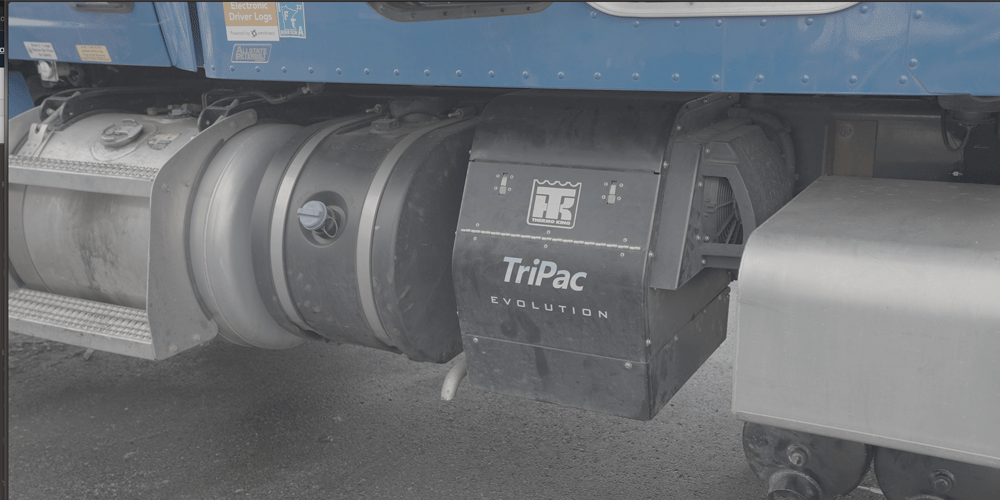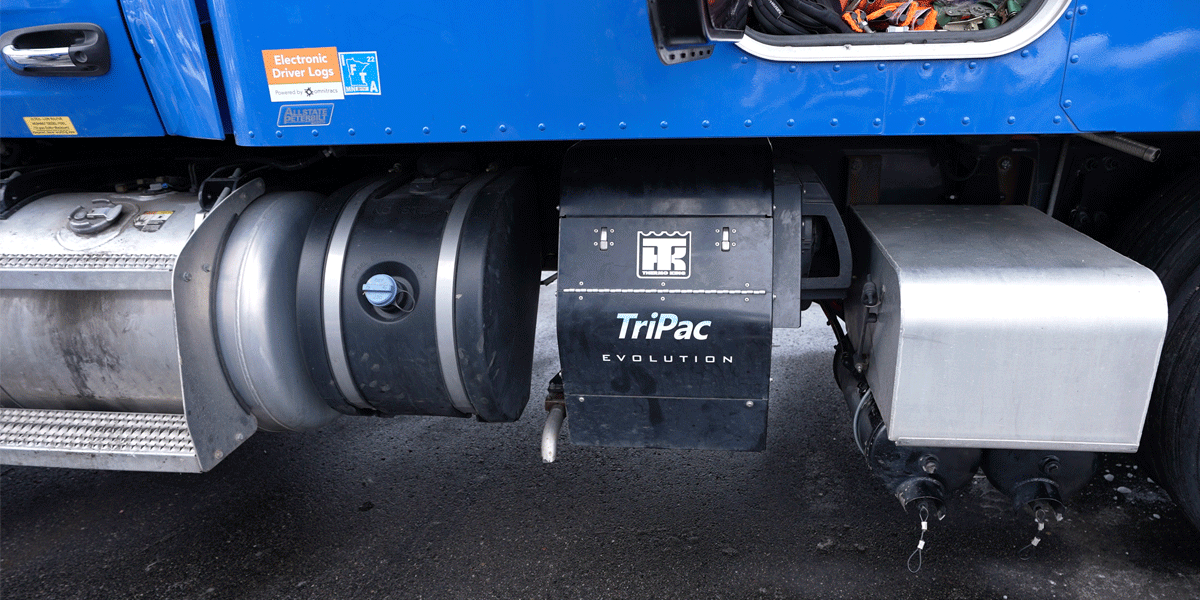Justin began working at ATS in 2016. He brought more than 20 years of experience in mechanics and leadership to the role. He started at ATS as the first mechanic trainer and now leads a team of two other trainers and an in-cab technology specialist. He loves spending time researching to ensure that the trucks are being repaired correctly and passing that information down to improve the whole ATS maintenance team.
Why are there regulations and restrictions on idle time?
Idle time happens when the engine is running but the truck isn’t moving.
Trucks weren’t designed just to sit there not moving, so excessive idle time can be hard on the engine. Depending on how long you idle, you can do some damage to some of the systems in your semi-truck.
Because of that, some trucking companies may put idling restrictions on their trucks — especially if the truck already has an auxiliary power unit (APU) to keep it cool in the summer and warm in the winter. Not only that, but some states have anti-idling rules you must follow.
However, anti-idling laws and restrictions can be frustrating and annoying if you don’t know why they’re put in place by your company or state. It can seem like your company just wants you to control you.
As the technical service manager in the maintenance and road service department at Anderson Trucking Service (ATS), I know the ins and outs of truck idling rules and why they’re in place.
I’ll help you understand what idling parameters are, why it benefits you to limit your idle time and how you can work with anti-idling laws.
What Are Idling Laws and Regulations?
Idling laws are in place across states, cities and counties to limit emissions in general — or near neighborhoods and schools. Idling laws aren’t federally mandated. If you don’t follow these ordinances, you can be slapped with a hefty fine.
A lot of trucking companies have idling parameters set on their trucks — and ATS is no different. We have idling parameters set on our company trucks with APUs. If the truck is being leased, these same idling parameters may not be placed on the truck at some companies.
Every company sets up different idling rules For example, the regulations at ATS are set between five and 90 degrees. If the truck is between those temperatures, once it’s idling for longer than five minutes, the truck will shut off. Outside of those temperatures, the APU can struggle to either warm the vehicle up or cool it down, so drivers are allowed to idle.
APUs don’t run while the truck idles. The small engine is attached to the side of the truck and runs off diesel fuel. They run on significantly less diesel than the truck does. APUs help maintain a comfortable temperature in the truck. However, in extreme temperatures, they may not work optimally.
Some APUs only provide a cooling system, while some provide both. In cases where a heating system isn’t incorporated into the APU, drivers typically invest in bunk heaters.
Related: State and local idling laws
Why You Should Limit Idle Time [4 Reasons]
Idling parameters can be frustrating, especially if you don’t have an APU (though, typically, idling parameters are set by companies who have APUs in the truck).
However, even if you don’t have an APU or you’re just running on your own, you should consider limiting idle time based on the following reasons.

Reason #1: It’s Costly
The biggest deterrent to idling your truck extensively is that it burns up a lot of fuel. On average, an idling truck burns a gallon of fuel per hour. In comparison, an APU only uses about one gallon every four hours.
At the time of this writing, diesel is $4 per gallon. If you idle your truck overnight while you sleep during your 10-hour break, you’ll burn 10 gallons of fuel and spend $40. If you utilize an APU, you’ll use 2.5 gallons of fuel and only spend $10. Over a week, the cost savings really add up — $280 compared to $70.
If an APU helps save $210 on fuel each week, imagine the savings that would accrue over a year for a fleet of 1,000 trucks. It would be millions of dollars.
If you’re a company driver, you won’t pay for fuel, but if you’re leasing your truck, you will. The fuel savings with an APU go directly into your pocket. They’ll either help you cover other expenses or line your pockets.
If you don’t happen to have an APU, you may decide to invest in one. An APU can cost upwards of $10,000, so it’s quite the investment. However, if you’re saving around $210 per week, a $10,000 APU would pay for itself in about a year. After you pay it off, you’d be putting almost $10,000 in fuel savings in your pocket each year. If you plan on keeping your truck for a while, it might be worth the investment to you.
Reason #2: It’s Hard on Your Truck
Trucks are manufactured to run optimally out on the road. When the truck sits idle, it’s not working at optimal capacity. Fuel doesn’t burn off as cleanly. This can result in problems for your engine and emissions system.
When the engine and emissions system aren’t running at full capacity, the exhaust gas doesn’t burn cleanly and it can clog the air intake and emissions system.
Excessive idle time can also cause the truck to derate while going down the road. Engine derating happens when the engine’s output is reduced because operating conditions aren’t ideal.
The engine will derate when it’s trying to prevent further damage to the truck. The truck’s speed will drop to 55 miles per hour (mph) and then 5 mph. No driver wants to be going down the road and have their engine derate.
Reason #3: You Might Have to do More Preventative Maintenance
Some service intervals are based on engine hours — or number of hours the engine is running (whether it’s idling or being driven). For instance, oil changes can be based on engine hours. Drivers who idle all night every night will wrack up their engine hours, which means they’ll be in the shop more frequently for service intervals.
Consider the cost of an oil change. It’s a fairly simple service, but you have to put in 40 quarts of oil, which isn’t cheap these days, plus pay for the labor. If you’re looking to save money, going in for extra service intervals because you idled the truck a lot is certainly not the way to get ahead.
Reason #4: It Can Prevent You From Getting Warranty Coverage
Remember when I mentioned idling can clog the engine and emissions system? If you take your truck in for a repair associated with this, they’ll look at your engine hours or idle time. If you’ve idled excessively — let’s say 30 percent or higher — you may not qualify for warranty coverage to get the emissions system fixed.
Each manufacturer is different and has varied idling regulations. However, companies typically like to see your total idle time at 20 percent or lower.
Whether or not you have an APU, it’s in your best interest to limit idle time so you can get warranty coverage on your truck should something go wrong with your emissions system or engine.
Not only that but limiting idle time will also prevent you from getting a ticket in anti-idling areas.
What Can I Do Instead of Idling?
Wondering what you can do instead of idling?
For starters, if you have an APU, use it. And if you don’t, consider investing in one.
However, if you don’t want to pay for an APU (and the maintenance it’ll require), you have a few other options.
With a power inverter — which connects to the battery on your truck — you can run a fan to keep your cab cool. Inverters are usually only a couple hundred dollars.
A bunk heater — while often used in conjunction with an APU — runs on diesel without the need for an APU. It’ll keep you warm in the winter and only uses 0.07 gallons of fuel per hour.
To learn more about your options, check out this article about APUs and their alternatives.
Lowering Your Operating Costs
Understanding idling parameters and their importance is crucial for truck drivers and companies alike. The benefits of idling parameters include significant cost savings on fuel consumption, better preservation of the truck's engine and emissions systems and eligibility for warranty coverage.
For drivers without APUs, investing in these systems can prove cost-effective in the long run, as the fuel savings and reduced maintenance costs can outweigh the initial investment. Moreover, exploring alternative options such as power inverters and bunk heaters can help minimize idling without compromising driver comfort.
By comprehending the rationale behind idling parameters and proactively managing idle time, drivers can improve their overall trucking experience while promoting eco-friendly practices and financial savings for themselves and their companies. Adopting responsible idling practices not only benefits individual drivers but also contributes to a more sustainable and efficient trucking industry.
Learn more about how APUs work.
Learn more about how to lower your operating costs on the road.

